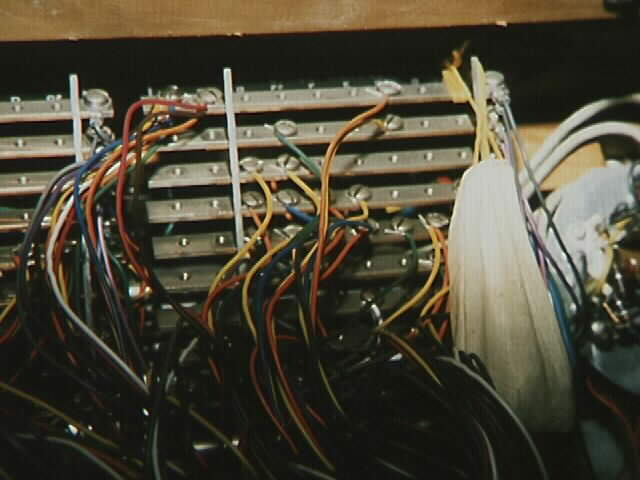The preset panel is a set of terminals which allows the user to rewire the C# through A presets. This panel is accessed from behind the organ.
Here's a picture of a preset panel:

(Often, a little cloth bag of screws (for altering the presets) is found hanging on the preset panel.)
See StandardPresets for a list of the standard (i.e. factory-fresh) presets.
The organs which have preset panels came with a card with instructions on how to change the presets,
and which had a spreadsheet on which one could note the currently wired-up preset settings.
A scan of this card is available in the  A-100 manual (figure 17)
The text of the card follows~:
A-100 manual (figure 17)
The text of the card follows~:
Preset Panel
The tone signals from the preset keys are carried by color-coded wires to the divided preset panel in the back of the console.
Each preset wire, carrying a single harmonic, is fastened under a screw on the bar which represents the desired intensity of that harmonic.
This is equivalent to setting a harmonic drawbar to the corresponding number.
One part of the preset panel is used for the swell (upper) manual and the other for the great (lower) manual and pedals.
When shipped each organ has its presets set up as shown in the playing instructions furnished with the organ.
Preset combinations may be changed at will by removing the console back and following the directions on a card inside.
This card is reproduced below. (Figure 17)
Directions for Making Pre-Set Panel Connections
There are 9 color-coded wires threaded through one of the lower holes for each pre-set key.
Above each hole are 9 binding posts arranged in vertical order,
and above the uppermost binding post is a name plate specifying the pre-set key associated with the row of wires below.
The lowest binding post is that of zero strength and corresponds to a harmonic control pushed all the way in.
The uppermost binding post is of 8 strength and corresponds to a harmonic control drawn all the way out.
The bus-bar strips for each level are extended to the left where they are marked with their appropriate strength numbers.
For example, suppose the combination 006523411 is to be set up on the D# of the upper manual.
It will be found helpful, especially when setting several combinations, to use the follow chart:—
<?plugin ?OldStyleTable
| Manual | Key | Brown | Red | Orange | Yellow | Green | Blue | Violet | Grey | White
| Upper | D# | 0 | 0 | 6 | 5 | 2 | 3 | 4 | 1 | 1
| | | | | | | | | | |
| | | | | | | | | | |
?>
With a screw driver remove the connections already made on the D# "Upper Manual" row of binding posts
and separate the 9 wires from each other.
Referring to the chart above, the brown and red wires are twisted together and connected with the binding post
on the level marked "0" (lowest level).
Next the white and grey wires are inserted under the binding post on the level marked "1".
Similarly, the green wire is connected on level "2," the blue wire on level "3,"
the violet wire on level "4," the yellow wire on level "5,"
and the orange wire on level "6."
The binding posts should be firmly tightened over the wires to insure good electrical contacts.
<?plugin ?OldStyleTable
|||^ *Color Code Explanations*
||| Each group of 9 wires is color-coded as follows:
| Sub-fundamental | (brown drawbar) | brown wire
| Sub-3rd harmonic | (brown drawbar) | red wire
| Fundamental | (white drawbar) | orange wire
| 2nd Harmonic | (white drawbar) | yellow wire
| 3rd Harmonic | (black drawbar) | green wire
| 4th Harmonic | (white drawbar) | blue wire
| 5th Harmonic | (black drawbar) | violet wire
| 6th Harmonic | (black drawbar) | grey wire
| 8th Harmonic | (white drawbar) | white wire
?>
The content of this page is Copyright (C) 2000, 2001, 2002 Geoffrey T. Dairiki and
the other authors of the content, whoever they may be.
This is free information and you are welcome redistribute it
under certain conditions; see
http://www.dairiki.org/HammondWiki/opl.html for details.
Absolutely no warrantee is made as to the correctness of
the information on this page.